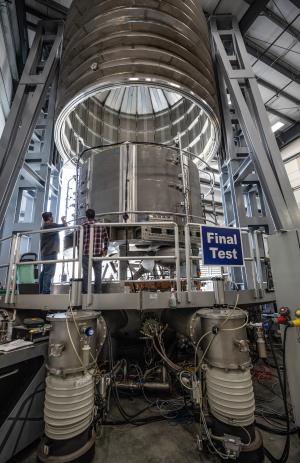First module gets clean bill of health
After enduring a battery of rigorous tests, the first of seven superconducting magnet modules that will make up the beating heart of the ITER international fusion reactor has earned a clean bill of health.
As expected for such a first-of-its-kind device, engineers encountered and overcame challenges over two years of deliberate probing, said Kathy McCarthy, associate laboratory director for Oak Ridge National Laboratory's (ORNL's) Fusion and Fission Energy and Science Directorate and director of the US ITER Project. "This module went through rigorous testing and emerged much better for it," McCarthy said. "The tougher the vetting, the higher the confidence in the central solenoid's performance. And we are now confident."
The module, built at San Diego-based General Atomics under the direction of the US ITER project headquartered at ORNL, will head to France later this year, where ITER assembly is already underway. In due course, it will be followed by six companion modules (one to serve as a spare) now in production that will together form ITER's central solenoid, one of the most complex and challenging magnet systems ever built.
The successful testing of the first module is a crucial milestone for the ambitious ITER project. Although the central solenoid has also been likened to a backbone with its coils stacked like vertebrae, the heart may be the more apt metaphor. The 45,000 amps of electricity that will course like blood through its niobium-tin wires will generate a strong magnetic field that plays the critical role of steering and shaping an intensely hot, energy-producing plasma circling around it.
"There is no ITER without the central solenoid," said David Everitt, US ITER's central solenoid systems manager. The central solenoid is one of 12 hardware systems that US ITER, funded by the Department of Energy Office of Science Fusion Energy Sciences, is providing to the project.
As the first of the solenoid modules, the 4.3-metre-wide, 113-tonne module was subjected to a series of demanding tests throughout and after its production at General Atomics and components were evaluated at SULTAN, a facility in Switzerland that tests high-current superconductors.
The module was subjected to the same extreme conditions it will face at ITER, including vacuum, high current and frigid temperatures (4 K, or minus 270 degrees Celsius) required for niobium-tin to be a superconductor.
One of the thorniest problems the team had to solve was created by the coaxial joints that connect the module to its power source to generate a magnetic field. Because of the extreme cold required for superconducting, any heat-creating resistance that might occur across the numerous joints in the system had to be kept to an absolute minimum—within just a few billionths of an ohm—so as not to overheat the precious liquid helium that keeps the magnet cold.
While some joints exceeded these demanding requirements, the coaxial joints fell short, and it took the better part of two years to troubleshoot the issue. Repeatedly disassembling and reassembling the joints, the team cycled through a series of approaches, eventually arriving at a redesign that kept resistance within the project's strict parameters.
A design modification also resulted from another skull-scratcher engineers encountered with the coil's quench detection system. If the current anywhere along the 5.6 km of superconductor in the module encounters too much resistance, the resulting heat can raise the magnet above the frigid temperatures required for it to operate—prompting an event called a quench. Tests revealed that, due to an incompatibility between the coating on quench detection wires and the epoxy used to insulate the superconducting cables, the wires could crack. After months of troubleshooting, the team engineered a solution that cleared a high but critical hurdle, called a Paschen test, that assessed the system's performance under the more demanding conditions of a vacuum.
"If you can pass these severe Paschen tests," said Everitt, "you can have very high confidence in your insulation system."
The vetting process required time and patience. But engineers deftly adapted, said Graham Rossano, US ITER's technical division director.
"The team has done a good job of maintaining production and testing throughout the pandemic. And we're confident of the performance because we did full-power testing at temperature."
Numerous other partners contributed to the success as well—from ITER Japan which provided the superconductor, to staff at the ITER Organization, vendors and external advisors.
"It's amazing thinking how many heartbeats have gone into this thing," Everitt said.
Lessons learned on this first module have been applied to the fabrication of subsequent coils. The second module is now undergoing its own battery of tests and is expected to ship to ITER just after the first in mid-2021.
As knowledge is shared throughout the broader scientific community, this pioneering work will also benefit efforts outside of ITER and help advance future magnets for fusion and other applications.
See the original story on the US ITER website.



